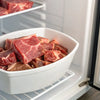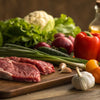How Much Raw Food Should You Feed Your 50 lb Dog?
- Houndsy
Table of Contents
- Introduction
- Why Choose Raw Food for Your Dog?
- Guidelines for Feeding a 50 lb Dog
- Tips for Transitioning to a Raw Diet
- Ensuring a Balanced Raw Diet
- The Houndsy Kibble Dispenser: Elevating the Feeding Experience
- Conclusion
- FAQs
Introduction
Did you know that maintaining the correct diet for your dog can significantly enhance their quality of life? Studies show that approximately 60% of dogs are overweight, which can lead to serious health issues like diabetes, arthritis, and even reduced lifespan. As responsible pet owners, it's essential to understand how much raw food to feed a 50 lb dog, ensuring they receive the nutrition they need while maintaining a healthy weight.
Feeding a dog raw food is a growing trend among pet parents aiming for a more natural and nutritious diet. However, determining the right amount can feel complex. By the end of this blog post, you’ll learn the recommended feeding guidelines, factors to consider when calculating food portions, and best practices for transitioning your dog to a raw diet.
This comprehensive guide will cover:
- Why choose raw food for your dog
- Guidelines for feeding a 50 lb dog
- Factors influencing food intake
- Tips for transitioning to a raw diet
- Additional insights to improve your dog’s feeding experience
Let’s embark on this journey together, ensuring our furry friends receive the best care possible.
Why Choose Raw Food for Your Dog?
The lure of a raw diet is enticing for many dog owners. It closely resembles what wild canine ancestors would consume and offers numerous benefits. Here are a few compelling reasons why more pet parents are opting for raw:
Improved Digestion and Nutritional Benefits
Raw food typically consists of a high protein content and fewer carbohydrates than traditional kibble. This can lead to better digestion and nutrient absorption. Many pet owners report improved coat condition, healthier skin, and even increased energy levels after switching their dogs to a raw diet.
Weight Management
For dogs struggling with their weight, a raw diet allows for controlled portion sizes without fillers like grains. For active dogs, raw food can support muscle development and help maintain an ideal weight, while less active dogs can benefit from portion control to avoid unwanted pounds.
Allergy Reduction
A raw diet can significantly reduce food allergies or intolerances. By eliminating grains and fillers, you can focus on high-quality proteins and vegetables that are more biologically appropriate for dogs.
Natural Dental Care
Chewing on raw meaty bones can help improve oral health. This practice can reduce tartar buildup and contribute to fresher breath, leading to healthier teeth and gums.
In essence, transitioning to a raw diet can evoke various positive changes in your dog’s health and happiness. But how can we determine the right amount of food to feed them? Let’s delve into the guidelines, specifically for a 50 lb dog.
Guidelines for Feeding a 50 lb Dog
When calculating how much raw food to feed your 50 lb dog, several rules of thumb exist. Generally, the recommended feeding amount for adult dogs on a raw food diet is 2-3% of their body weight, adjusted based on individual factors.
Standard Feeding Guidelines
Here’s a breakdown for dogs around 50 lbs:
- Inactive or Weight Loss: 2% of body weight = 1 lb (approximately 16 oz)
- Maintenance of Current Weight: 2.5% of body weight = 1.25 lbs (approximately 20 oz)
- Active Dogs or Weight Gain: 3% of body weight = 1.5 lbs (approximately 24 oz)
This range provides a solid foundation, allowing you to adapt based on your dog's specific needs. But why stick to these percentages?
Factors Influencing Food Intake
Several variables come into play when determining how much raw food for your 50 lb dog:
- Activity Level: Active dogs require more calories, whereas less active dogs need less.
- Age: Puppies and senior dogs have different nutritional demands compared to healthy adult dogs.
- Health Conditions: If your dog has health issues or specific dietary restrictions, consult with your veterinarian on tailored feeding recommendations.
- Metabolism: Every dog has a unique metabolic rate, and closely monitoring your pet's weight and body condition will be essential for adjustments.
By observing these factors, you can confidently adjust your dog's diet, ensuring they thrive on their raw food regimen.
Tips for Transitioning to a Raw Diet
Transitioning from traditional kibble to a raw diet can be a sensitive process for some dogs. Here are best practices to make this change as seamless as possible:
Gradual Transition
Instead of making a sudden switch, gradually introduce raw food into your dog's diet. Start with 25% raw food and 75% current diet for the first few days. Gradually increase the portion of raw food over a week until the transition is complete.
Sample Transition Plan:
- Days 1-2: 75% Current Diet, 25% Raw
- Days 3-4: 50% Current Diet, 50% Raw
- Days 5-6: 25% Current Diet, 75% Raw
- Day 7: 100% Raw Diet
Monitor for Reactions
While transitioning, keep an eye on your dog’s stools and overall behavior. Some dogs may experience loose stools initially as their digestive system adjusts, but this should stabilize within a few days.
Gradual Adjustments
Always remember to adjust portion sizes based on your dog's ongoing weight management. Being vigilant will help you identify the right balance between maintaining a healthy weight and ensuring your dog receives the necessary nutrients.
Ensuring a Balanced Raw Diet
Feeding raw isn't only about providing meat. A balanced raw diet typically includes a mix of proteins, organ meats, and vegetables. Here are the components of a well-rounded raw food diet for your dog:
Protein Sources
- Muscle Meats: Chicken, beef, lamb, pork, etc.
- Organ Meats: Liver, kidney, heart, and other organ proteins offer essential vitamins and minerals.
- Raw Meaty Bones: These provide calcium and help maintain dental health.
Vegetables and Fruits
Adding plant-based ingredients offers fiber and essential nutrients. You might include small amounts of:
- Carrots
- Spinach
- Pumpkins
- Blueberries
Supplements
Consider incorporating omega-3 fatty acids and probiotics into your dog's diet, especially when transitioning, to support digestive health.
The Houndsy Kibble Dispenser: Elevating the Feeding Experience
Here at Houndsy, we cherish the dog feeding experience, and changing up your dog’s diet can be an exciting part of that journey. Our flagship product, the Houndsy Kibble Dispenser, is designed to simplify and elevate your daily feeding routine.
With a mid-century modern design that harmonizes with your home decor, it allows for perfect portion control, ensuring your 50 lb dog gets just the right amount of raw food every time. The auto-locking mechanism ensures safety for curious pets or toddlers while the large storage capacity keeps feeding seamless and hassle-free.
Explore how the Houndsy Kibble Dispenser can enhance your experience and elevate your dog’s feeding ritual.
Conclusion
Understanding how much raw food to feed your 50 lb dog is essential for nurturing their health and happiness. Adopting a raw diet can lead to numerous benefits, but it’s crucial to remain attentive to your dog’s specific needs and preferences.
By observing their weight, activity level, and overall health, you can tailor their meals for optimal nourishment. The transition requires patience, but with a solid plan in place, you’ll set your furry friend on a path to better health.
As you explore this new journey, consider how the Houndsy Kibble Dispenser can simplify the daily feeding experience, ensuring convenience, consistency, and beauty.
Ready to elevate your dog’s feeding routine? Check out the Houndsy Kibble Dispenser today!
FAQs
1. What if my dog refuses raw food?
Dogs can be finicky eaters, especially when transitioning diets. Start by mixing raw food with their usual kibble in small amounts until they adjust. Gradually increase the raw portion as they grow accustomed to the new tastes.
2. Can I mix raw food with kibble?
While it’s often suggested to keep raw food separate from kibble, some dogs transition better by incorporating both. However, most experts recommend feeding them at different times to prevent digestive issues.
3. How do I know if my dog is getting the right amount of food?
Monitor your dog's weight and condition. A healthy dog should have a waist when viewed from above, and you should be able to feel their ribs without excess fat covering.
4. Is it safe to feed my dog bones?
Yes, feeding raw meaty bones is considered safe and beneficial. Avoid cooked bones, as they can splinter. Always supervise your dog when they are chewing on bones.
5. Do I need to add anything to a raw diet for it to be balanced?
Yes, a balanced raw diet typically includes a variety of protein sources, organ meats, and vegetables. Consider consulting your veterinarian for tailored nutritional advice.
By following these insights, you can confidently embrace a raw food diet for your 50 lb dog, reinforcing your bond while ensuring their health and happiness.












